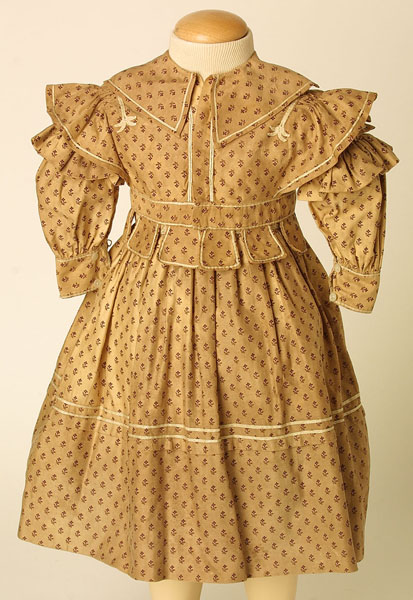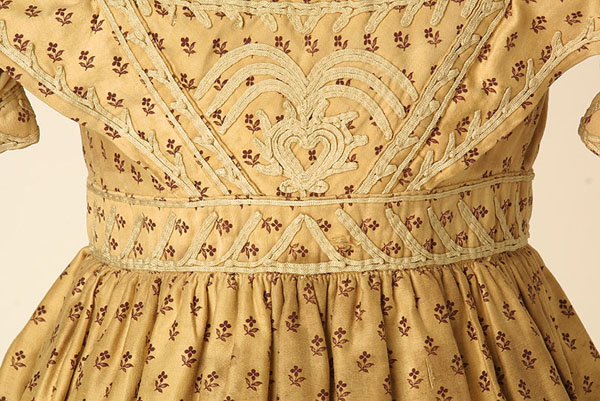dress
Summary
Girl's dress in yellowish fawn cotton satin, printed with small sprig design in puce; wide rounded neck, and short, puffed sleeves; fastening at neck with drawstring and pearl button and loop, two pearl buttons at waist; bodice front in one bias-cut section, back in one section each side of centre back opening, pleated at back of neck and onto cotton-lined waistband; neck, collar, waistband and sleeveband trimmed with cream silk braid and heart design centre front above waistband in same braid; skirt in two widths gathered to bodice, two lines of braid at top of deep hem. Skirt has been shortened at waist by 5.5 cm, as evidenced by previous stitch marks and threads. Detachable oversleeves: Long oversleeves, cut in one section, gathered to shoulder and to wide wristband edged with braid, fastening with two buttons and loops; gathered tuck above elbow forming frill, slightly wider at outer arms; fastening with loops to two pearl buttons on shoulder of dress, concealed under collar. Overbodice: Front fastening with two pearl buttons and button loops at cotton-lined waistband and three more above to high round neck with turn-down collar, narrow at back; front and back each tapering to centre waist, cut in one section each side, seamed over shoulders and down centre back, in one piece with frill gathered on shoulder and just below shoulder, wide on shoulder and tapering to waist; collar, front edges, shoulder frill, shoulders, waistband and tabs below waistband all trimmed with cream silk braid.
Display Label
In the sixteenth and seventeenth centuries, children were usually dressed in miniature versions of adult dress, encumbered with heavy fabrics and formal styling, and then exhibited socially with their parents. During the eighteenth century, this tradition weakened, so that by 1800, children wore much looser and more practical outfits; girls in muslin or stout cotton frocks, and boys in linen or cotton skeleton suits and later woollen jackets and breeches. The Gallery has a good collection of nineteenth century children's clothing, particularly girl's dresses, a few examples of which are illustrated. Striped and patterned cottons were the usual material for such dresses, easily washable, and passed on from sibling to sibling, and then to cousins or friends. They were invariably home-made at this time, and often utilised fabric from worn adults' clothing, which could be cut up and re-used. During the nineteenth century, boys wore similar dresses to girls, until the age of 4 or 5, when they were "breeched" and put into little suits, like their fathers. The watercolour portrait shown below has a mother with her 3 children, both boys and girls in similar frocks or dresses, whilst the coloured fashion plate of about 1860 shows a gaggle of girls playing outdoor in replica versions of women's dress, complete with crinolines, but cut shorter to show the pantalettes below.
Object Name
dress
Date Created
1836-1840
Dimensions
Circumference (hem): 130cm
Length (bodice): 18cm
Waist: 53cm
Length (dress): 54cm
Waist (bodice): 54cm
accession number
1947.2087
Collection Group
Medium
Legal
© Manchester Art Gallery



